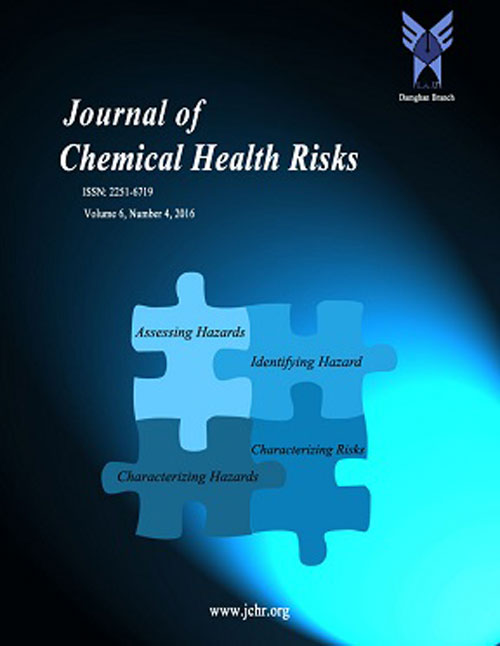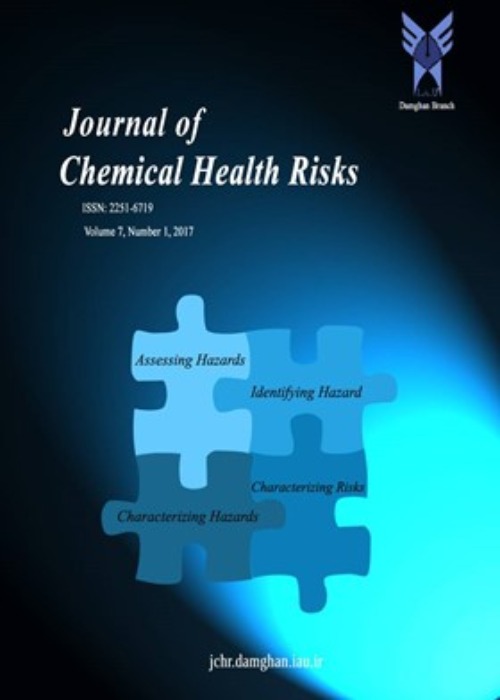فهرست مطالب

Journal of Chemical Health Risks
Volume:8 Issue: 3, Summer 2018
- تاریخ انتشار: 1397/07/11
- تعداد عناوین: 7
-
-
Page 183Most of the studies assessed the effect of Pb-exposure on serum total calcium and phosphorus. This study assessed the effect of Pb- exposure on serum total calcium (TCa2+) and phosphorus (P) components such as corrected calcium (CCa2+), ionized calcium (ICa2+), percentage of ICa2+from TCa2+, percentage of ICa2+from CCa2+, ratios of TCa2+: P, CCa2+: P, ICa2+: P and product of Ca2+ and P in workers of different category of Pb-exposure. This study enrolled 176 male Pb-exposed workers and categorized into two groups based on blood lead levels (BLLs) recommended by BEI-ACGIH. The low Pb-exposure group is 86 workers with their BLLs is ≤ 30 µg/dL and high Pb-exposure is 90 workers with their BLLs is > 30 µg/dL). 80 healthy workers with no occupational exposure to Pb were included them as control for the comparison. The serum calcium, phosphorus and albumin concentrations were done by using diagnostic kit methods. BLLs were estimated by using the flame atomic absorption spectrometric method. The serum TCa2+, CCa2+ and ICa2+ were significantly decreased in low and high Pb-exposure groups as compared to control. The ratios of TCa2+: P, CCa2+: P, ICa2+: P was significantly decreased in the high Pb-exposure as compared to low Pb–exposure and controls. Product of TCa2+X P was significantly increased in the high Pb-exposure group as compared to low Pb- exposure. A negative association was noted between BLLs and serum TCa2+, ICa2+and CCa2+ in a high Pb- exposure group. The components of serum calcium and phosphorus were significantly altered in Pb- exposed workers.Keywords: Serum total calcium, Ionized calcium, Corrected calcium, Phosphorous , Product of calcium, phosphorus, Ratio of calcium, occupational Pb- exposure
-
Page 191The studied substrates included soil, soil + leaf mold, soil + cocopeat, soil + perlite, and soil + vermicompost arranged in a Randomized Complete Block Design with three replications. The results showed that the highest germination speed (18) was related to soil and that the highest flower fresh weight (9.25) and flower diameter (52.3) were related to soil + perlite. Substrates did not impact floret number, root length, and flowering time significantly. The highest flower longevity (7 days) was observed in soil + leaf mold. Results of analysis of variance did not display the significant influence on stem length, root length, floret number, leaf number and chlorophyll and flowering time. The results showed that the addition of materials such as vermicompost to soil could improve the important traits of Narcissus flower, including flower life, germination rate and stem diameter, thus reducing the use of chemicals.Keywords: Flower longevity, Fresh weight, Narcissus, substrate
-
Page 199Iron is one of the most important elements for plant growth and metabolism. Plant growth promoting bacteria such as Pseudomonas fluorescens isolates play an important role in the absorption of iron by plants under iron deficiency by production of microbial siderophore. In this study, 25 bacterial isolates were isolated from corn plants rhizosphere in Khorasan Razavi Province, Iran in 2017. Based on physiological-biochemical and molecular diagnostic methods, by using 16SPSEfluF and 16SPSER specific primers, bacterial isolates were identified as P. fluorescens. Among these isolates, the highest amount of siderophore production was related to the isolate PFD1 and the lowest to the isolate PFD3. Moreover, in the study of iron absorption by corn (Single Cress 704), the highest iron absorption was obtained from PFG5 treatment (283 ± 2/3 ppm) and the lowest from control treatment (7/1 ± 6/107 ppm). Isolate PFG5 showed the highest yield increase on fresh and dry weight of root and aerial parts among treatments. PFG5 isolates could be introduced as an effective isolate in iron deficiency conditions.Keywords: Iron, Specific primer, Single cross 704, PFG5 isolate
-
Page 209A factorial experiment with the split plot arrangement using the complete randomized block design with three replications was carried out adjacent to the Agriculture School of Shahrood University of Technology in 2010-2011 to study the effects of sulfur and Thiobacillus application and zinc and molybdenum sprays on some traits of green beans. The treatments included three levels of sulfur (zero, 100 kg/ha of sulfur powder, and 100 kg/ha of sulfur powder + Thiobacillus bacteria) as the main factor, and three levels of zinc spray (0, 5, and 10g/l) and two levels of molybdenum spray (0 and 0.5 g/l) as the sub-main factors. The treatments that included sulfur were applied before seeding. Zinc (using zinc sulfate) and molybdenum (using sodium molybdate) were sprayed during the growing season and 5 weeks after planting. Results showed the treatment of applying sulfur at 100 kg/hectare and Thiobacillus bacteria increased leaf fresh and dry weights by 57 and 54%, mean pod length by 14%, and number of lateral branches by 25% compared to the control. Moreover, this treatment increased pod fresh and dry weights by 41.6 and 42.11%, respectively, compared to the treatment of not applying sulfur, and improved yield by 42% compared to the control. Considering the results concerning yield in response to sulfur, zinc, and molybdenum, it can be said that application of sulfur and Thiobacillus together with zinc spray can be very useful in growing green beans.Keywords: Zinc sulfate, Green beans, Sodium molybdate, Sulfur powder, Yield
-
Page 223Graphene oxide is a derivates of graphene that has a ultrahigh specific surface space with variety of chemically reactive functionalities, such as epoxy and hydroxyl groups on the basal plane and carboxylic acid groups along the area edge, which can be use different groups for functionalization, consequentlyit has a great promise for use as sorbent materials. On the other hand silica is well-known one of the best sorbent for adsorption that we use it as substance for coated on the graphene oxide for produce an ultra-sensitive sorbent. A new technique using a solid phase extraction (SPE) cartridge with graphene oxide functionalized by silica as sorbent was developed for the preconcentration of trace amounts of copper and was determined by flame atomic absorption spectrometry (FAAS). Some of the important parameters were selected and optimized. Under the optimized conditions the limit of detection (LOD) and limit of quantification (LOQ) were 0.175, 0.585 and the proposed method has a good reproducibility 0.85% (RSD %). The enrichment factor was 200 and the percentage of recovery was in the range of 97-100% .The method was successfully applied to the recovery of Cu2+ in different type of water samples. Graphene oxide and its derivates such as GO@SiO2 in this study are full of potential to use as an excellent adsorbent in the extraction method like solid phase extraction (SPE).Keywords: Graphene oxide, Silica, SPE, Preconcentration, FAAS, Copper
-
Page 239For evaluate the application of a bio-fertilizer on zinc and iron concentration in wheat, under cadmium stress, a greenhouse experiment was conducted in factorial design with three replications. Treatments included Arbuscular Mycorrhiza levels (Control, Glomus mosseae and Glomus intraradices) and cadmium with six levels (0, 5, 10, 20,40 and 80 mg.kg-1). The measured data showed that the effects of treatments were significant on zinc and iron concentration. Arbuscular mycorrhizal fungi increasing zinc and iron concentration in plant. Glomus intraradices species increased zinc concentration in shoot and root % 252 and %222, respectively. But Glomus mosseae species increased iron concentration in shoot and root % 148 and %170, respectively.Keywords: Arbuscular mycorrhizal, Bio-fertilizer, Cadmium, Soil contaminate Wheat
-
Page 245A simple and efficient ionic liquid-based ultrasound-assisted in-situ solvent formation microextraction (IL-UA-ISFME) in combination with high-performance liquid chromatography-ultraviolet detection (HPLC-UV) has been gainfully developed for the trace determination of four phthalate esters (PEs) in environmental water samples. In this method, a hydrophobic ionic liquid (1-butyl-3-methylimidazolium hexafluorophosphate) was created by addition of a hydrophilic ionic liquid (1-butyl-3-methylimidazolium tetrafluoroborate) to sample solution constituting an ion-pairing agent (NaPF6). The analytes were extracted inside the ionic liquid phase while the microextraction solvent was dispersed through the sample by utilizing ultrasonic radiation. The sample was then centrifuged and extracting phase retracted into the microsyringe, diluted with acetonitrile, and injected to HPLC. At first, vigorous parameters controlling the performance of the microextraction process were considered and optimized. The limit of detections (LOD, S/N = 3) were in the range of 0.22-0.33 µg L-1 while the RSD% values were below than 6.1% (n = 5). A good linearity (0.996 ≥ r2 ≥ 0.992) and a broad linear over the concentration range from 1.0 to 500 µg L-1 were achieved. At last, the method was applied for the preconcentration and sensitive determination of the PEs in several environmental water samples. The accuracy of the method in the real samples was examined by the relative recovery experiments with results ranging from 90-107%, which approved that intricate matrixes had approximately slight effect on the developed procedure.Keywords: Environmental water samples, High-performance liquid chromatography, Ionic liquid, Microextraction, Phthalate esters


